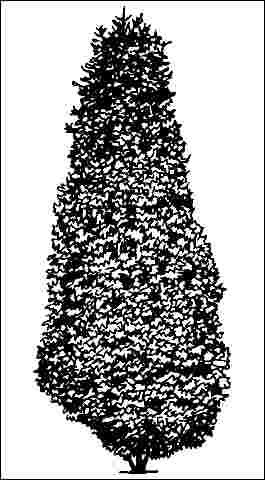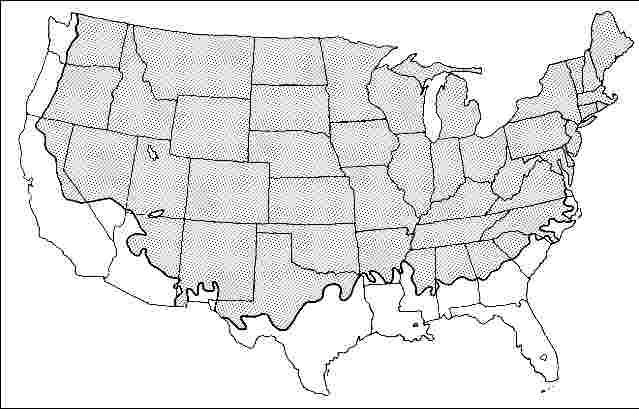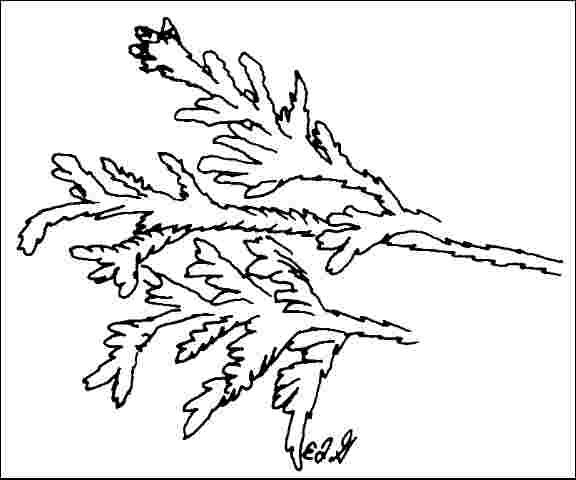Introduction
This slow-growing tree reaches 25 to 40 feet in height and spreads to about 10 to 12 feet wide, preferring a wet or moist, rich soil. Transplanting is moderately easy if plants are root-pruned and either balled and burlapped or potted. White cedar likes high humidity and tolerates wet soils and some drought. The foliage turns brownish in winter, especially on cultivars with colored foliage and on exposed sites open to the wind.

General Information
Scientific name: Thuja occidentalis
Pronunciation: THOO-yuh ock-sih-den-TAY-liss
Common name(s): White cedar, arborvitae, Northern white cedar
Family: Cupressaceae
USDA hardiness zones: 2A through 7B (Fig. 2)
Origin: native to North America
Invasive potential: little invasive potential
Uses: screen; hedge; specimen; reclamation; highway median
Availability: somewhat available, may have to go out of the region to find the tree

Description
Height: 25 to 40 feet
Spread: 10 to 12 feet
Crown uniformity: symmetrical
Crown shape: pyramidal
Crown density: dense
Growth rate: slow
Texture: fine
Foliage
Leaf arrangement: alternate (Fig. 3)
Leaf type: simple
Leaf margin: entire
Leaf shape: scale-like
Leaf venation: none, or difficult to see
Leaf type and persistence: evergreen, fragrant
Leaf blade length: less than 2 inches
Leaf color: green
Fall color: no color change
Fall characteristic: not showy

Flower
Flower color: yellow
Flower characteristics: not showy
Fruit
Fruit shape: cone, oval
Fruit length: less than .5 inch
Fruit covering: dry or hard
Fruit color: brown
Fruit characteristics: does not attract wildlife; not showy; fruit/leaves not a litter problem
Trunk and Branches
Trunk/bark/branches: branches don't droop; not showy; typically one trunk; thorns
Pruning requirement: little required
Breakage: resistant
Current year twig color: green, brown
Current year twig thickness: thin
Wood specific gravity: 0.31
Culture
Light requirement: full sun, partial sun, or partial shade
Soil tolerances: clay; sand; loam; acidic; slightly alkaline; well-drained; extended flooding
Drought tolerance: moderate
Aerosol salt tolerance: low
Other
Roots: not a problem
Winter interest: no
Outstanding tree: no
Ozone sensitivity: tolerant
Verticillium wilt susceptibility: resistant
Pest resistance: sensitive to pests/diseases
Use and Management
Best used as a screen or hedge planted on 8- to 10-foot-centers. There are better specimen plants but it can be placed at the corner of a building or other area to soften a view. Many of the natural stands in the United States have been cut. Some remain in isolated areas along rivers throughout the East.
White cedar has given rise to many cultivars, many of which are shrubs. Cultivars include: 'Booth Globe'—low, rounded with a flat top; 'Compacta'—dense and compact; 'Compacta Erecta'—semi-dwarf, pyramidal; 'Douglasi Pyramidalis'—dense, columnar; 'Emerald Green'—good winter color; 'Ericoides'—dwarf, brownish foliage in winter; 'Fastigiata'—narrow, columnar; 'Globosa'—dense, rounded; 'Hetz Junior'—dwarf, wider than it is tall; 'Hetz Midget'—slow grower, quite dwarf, rounded; 'Hovey'—low and rounded; 'Little Champion'—globe shaped; 'Lutea'—yellow foliage; 'Nigra'—dark green foliage in winter, pyramidal; 'Pumila' (Little Gem)—rounded, dwarf; 'Pyramidalis'—narrow pyramidal form; 'Rheingold'—rounded form with yellow to bronze new growth; 'Rosenthalli'—dense, pyramidal; 'Techny'—pyramidal, dark green, hardy; 'Umbraculifera'—flat topped; 'Wareana'—low and dense, pyramidal; 'Woodwardii'—rounded and spreading.
Pests
Arborvitae leaf miner mines out the leaf tips, causing them to turn brown. Translucent areas are seen where the miner has been active.
Scales of several types infest the stems and foliage. Sprays of horticultural oil control overwintering stages.
Mites cause yellowing and speckling of the foliage. The mites are seldom noticed because they are so small.
Bagworms can devour large quantities of foliage very quickly.
Diseases
Leaf blight causes brown spots on the leaves in late spring. The affected foliage appears scorched, then drops.
